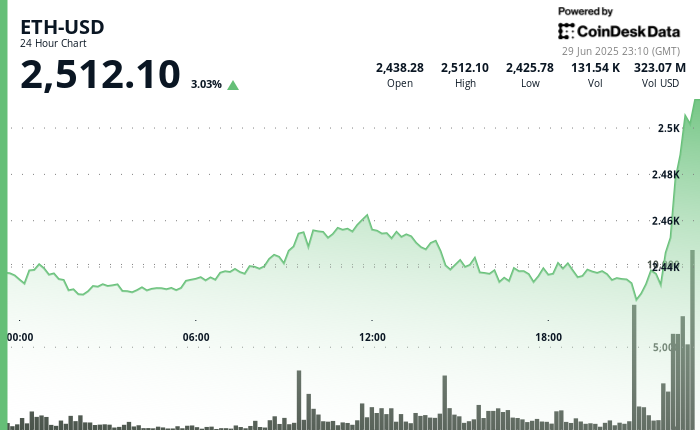
Digital
finance
technologies
hold
a
lot
of
transformative
potential.
Distributed
ledger
technology
(DLT)
–
of
which
blockchain
is
the
best
known
example
–
powers
digital
bond
issuances
that,
in
time,
could
lessen
the
need
for
intermediaries
in
the
issuance
process,
thereby
improving
operational
efficiency
and
potentially
reducing
costs.
DLT
also
underlies
tokenization
of
real
world
assets,
which
could
increase
accessibility
of
certain
instruments.
However,
to
make
these
potential
benefits
a
reality
and
gain
wider
adoption,
in
Moody’s
view,
DLT-based
technologies
and
platforms
will
need
to
overcome
several
key
hurdles,
including
a
lack
of
interoperability
and
standardization
among
DLT
systems,
a
lack
of
reliable
digital
cash
options,
regulatory
uncertainty
and
technology
risks.
This
post
is
part
of
CoinDesk’s
“Crypto
2024”
predictions
package.
In
the
last
few
months,
an
increasing
number
of
institutions
have
begun
to
engage
with
permissionless
blockchain
via
both
pilot
studies
and
real
transactions.
Many
of
these
entities
gravitate
towards
Ethereum,
given
its
extensive
ecosystem
of
applications
and
networks
that
have
developed
their
own
user
base
and
product
offering
in
the
last
few
years.
As
an
open-source
public
blockchain,
Ethereum
provides
a
blockchain
base
layer
on
top
of
which
developers
can
build
solutions
for
sharing
data
and
value
across
other
networks.
Ethereum’s
flexible
design
and
its
multi-year
plan
for
upgrades,
including
ones
that
will
improve
interoperability,
have
made
it
a
popular
platform
for
digital
bond
issuances.
Large
institutions
such
as
the
European
Investment
Bank
have
issued
bonds
on
Ethereum,
which
was
also
the
blockchain
underlying
a
digital
green
bonds
Moody’s
rated
in
2023,
a
€10
million
senior
unsecured
digital
green
bond
issued
by
Société
Générale.
Over
time,
in
Moody’s
view,
public
blockchain
networks
like
Ethereum
and
traditional
infrastructure
will
be
more
interlinked,
which
will
enhance
blockchains’
use
cases,
promoting
industry
growth.
Asset
tokenization
–
converting
an
asset
such
as
a
fund,
real
estate
or
art
into
a
digital
token,
making
it
storable
and
transferable
using
DLT
–
has
been
gaining
ground
in
the
past
year.
Total
value
of
tokenized
real
world
assets
on
public
blockchains
increased
to
$2
billion
from
$1
billion
in
the
last
12
months,
and
Ethereum
currently
hosts
the
vast
majority
of
it.
One
factor
slowing
the
adoption
of
tokenization
is
a
lack
of
a
reliable
form
of
digital
cash,
which
has
led
market
participants
to
settle
transactions
off-chain
or
use
stablecoins.
Stablecoins,
a
cryptocurrency
whose
price
is
pegged
to
a
reference
asset,
such
as
fiat
currency,
are
a
form
of
digital
cash,
but
under
stressed
market
conditions
stablecoins
have
not
always
maintained
their
peg.
However,
two
other
forms
of
digital
cash
that
could
address
the
present
vulnerabilities
of
stablecoins
are
tokenized
bank
deposits
and
central
bank
digital
currencies
(CBDCs).
The
development
of
tokenized
bank
deposits
and
CBDCs
will
continue
to
progress
in
2024,
in
Moody’s
view,
although
their
degree
of
interaction
with
public
blockchains
is
still
unclear.
Legal
clarity
will
also
likely
improve
in
2024,
in
Moody’s
view,
as
regulators
progress
in
developing
frameworks
to
support
new
digital
assets
and
services,
although
not
all
regions
are
advancing
at
the
same
pace.
Regions
including
the
EU,
Singapore
and
the
UAE
could
all
attract
new
investors
as
a
result
of
new
customer
and
investor
protections
and
new
licensing
regimes
for
digital
assets.
The
U.S.,
meanwhile,
will
likely
continue
to
use
regulatory
enforcement
actions
to
establish
legal
precedent
within
the
digital
asset
marketplace,
as
development
of
a
digital
asset
framework
in
the
U.S.
remains
a
more
distant
goal.
